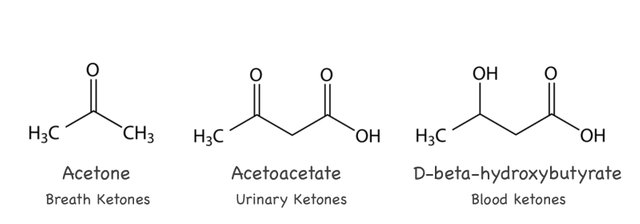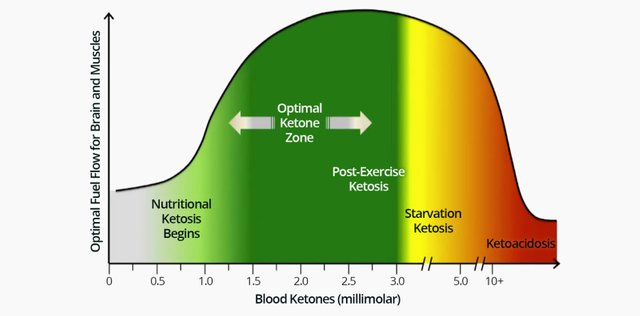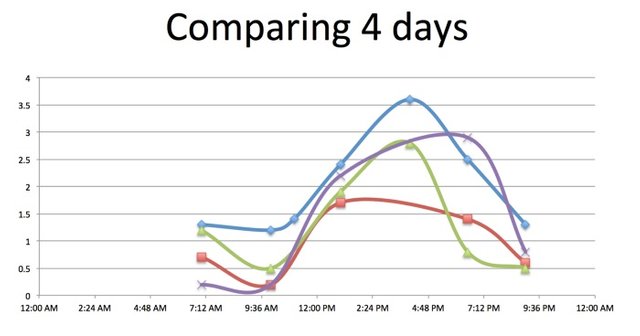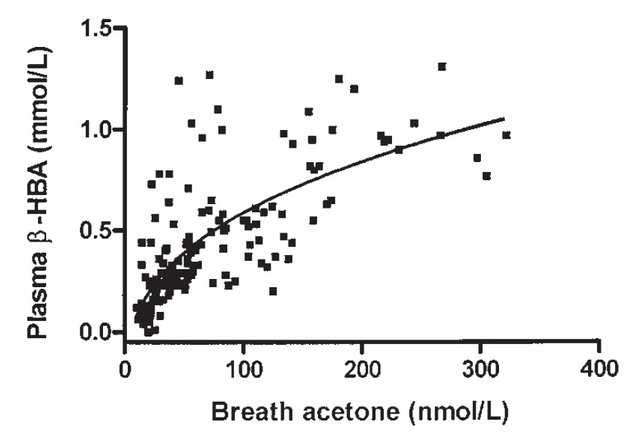Measuring Ketones

Following a ketogenic diet has many health benefits, but the immediate goal is to achieve nutritional ketosis. There is still no clinical definition of nutritional ketosis, but for our purposes it may be defined as a physiological state in which the liver is producing ketone bodies at such a rate that the concentration in the blood of one particular kind of ketone body exceeds 0.5 mmol L–1, or 0.5 mM.
In ketosis, the liver produces directly or indirectly three different types of ketone bodies by breaking down fatty acids:
- Beta-hydroxybutyrate (BHB)
- Acetoacetate (AcAc)
- Acetone (Ace)

Nutritional ketosis is defined by the concentration of BHB in the blood. A millimole (mmol) of BHB is approximately 0.104 g. Therefore, 0.5 mmol L–1, or 0.5 mM [“zero point five millimolar”], means a concentration of 0.052 g of BHB per litre of blood. If this level of concentration is reached, the subject is in nutritional ketosis. At the other end of the scale, if the concentration exceeds 3.0 mM, the subject has entered therapeutic ketosis (also known as starvation ketosis, as such levels of ketosis are generally achieved by prolonged fasting).

Nutritional ketosis happens when dietary carbohydrates are significantly reduced (<50 grams per day) and the body’s production of ketones increases to maintain a blood level at or above 0.5 mM. When you restrict carbs below 50 grams and consume a moderate amount of protein it is normal to have ketone levels of 0.5-3.0 mM. (Dr. Stephen Phinney and the Virta Team)
Everyone has their own unique carbohydrate tolerance, so some people may be able to eat 100 grams of carbs a day and be in nutritional ketosis, and some may only be able to consume 20 grams of carbs a day to enter ketosis. Most people need to keep their carbohydrate intake below 50 grams per day to maintain nutritional ketosis, although some people need to start out with an even lower carb amount, especially if they have type 2 diabetes or another metabolic issue. Thus, to ensure ketosis you may want to keep your carbs closer to 30 grams per day. (Dr. Stephen Phinney and the Virta Team)
The concentration of BHB in the blood is constantly fluctuating. It tends to increase the longer one fasts, and to decrease whenever food is consumed, insulin is raised, or blood sugar levels are spiked. Consuming caloric carbohydrates (such as sugars and starches) can be enough to “kick one out of ketosis”, whilst removing carbs from the diet will help to keep one in ketosis. Vigorous exercise can result in a decrease in blood ketone levels—not because the liver is no longer producing ketones, but because the ketones it is producing are being consumed faster than they are being produced. After vigorous exercise, on the other hand, the level of blood ketones may rise temporarily into the therapeutic zone before falling back into the nutritional zone.

Ketones in the Body
Almost everything that happens inside the human body requires energy. Usually, the immediate source of this energy is a molecule called ATP (adenosine triphosphate), which has been characterized as the human body’s molecular unit of currency. Most of this ATP is created by a complex series of chemical reactions called the Krebs Cycle and the Electron Transport Chain, which take place inside mitochondria, small organelles found in most of the body’s cells. The Krebs Cycle involves the oxidation of a molecule called acetyl-CoA. If you are following a typical glycogenic diet (hi-carb), this acetyl-CoA is formed mostly from glucose. If, however, you are keto-adapted, it is formed mostly from fatty acids. Excess acetyl-CoA is broken down into the ketone body AcAc, which in turn can be broken down into BHB and Ace.
AcAc and BHB can also be used as a source of acetyl-CoA, which then enters the Krebs Cycle and generates ATP. Two of the three main ketone bodies, therefore, can be used by the body as important sources of fuel. In ketosis, certain organs such as the brain are largely dependent on these ketone bodies (generated in the liver) for their energy. Skeletal muscles, however, generally rely on free fatty acids to create the acetyl-CoA for the Krebs Cycle.
The third ketone body, acetone, is typically not used by the body as a fuel source. Although it can be metabolized, it is usually excreted in the urine, the sweat and on the breath.
Measuring Ketones
How do you know whether your ketogenic diet is working? Is there some way of telling whether you are in nutritional ketosis? Can you measure your ketone levels without having to check yourself into a clinic?
Actually, there are four common methods of determining whether or not you are in ketosis. Three of these involve the direct measurement of the concentration of ketone bodies, while the fourth relies on the common symptoms of ketosis. Each has its advantages and its drawbacks, but there is not much to choose between them if you are a newbie to the ketogenic diet and all you want to know is: Am I in ketosis or not?
The question of whether you should continue to monitor your ketone levels once you are fat-adapted and have learned what works for you and what doesn’t is one I shall address in the next article. Here I will just say that I believe you should certainly monitor your ketone levels regularly for the first few months of your new regimen.

Blood Monitors
Since nutritional ketosis is commonly defined in terms of the blood concentration of BHB, the best way to determine whether or not you are in ketosis is to measure the blood concentration of BHB. This can be done using a small hand-held electronic monitor. You insert a test strip into the device, you prick your finger to produce a drop of blood, and you apply the drop of blood to the test strip. After just a few seconds, the screen will display the concentration of BHB in the drop of blood.
The most popular brand of BHB blood monitor in the keto community seems to be the Keto-Mojo, which can also measure your blood-glucose levels. You use different test strips depending on whether you are measuring BHB or glucose. A glucose reading takes five seconds, while a BHB reading takes ten seconds. The basic starter kit is currently about US$60.
There are a few downsides to the Keto-Mojo:
The initial cost of about $60 is modest, but not if you are on a tight budget.
You require a continual supply of disposable strips, each of which costs about $1.
Everytime you use the device, you must draw blood.
On the plus side, however, there a some decided advantages:
The device should last a lifetime, so the initial outlay of $60 is a one-off payment.
It is probably the most accurate way of determining your level of ketosis in the privacy of your own home.
It also measures your blood-glucose levels.

Breath Monitors
The second method of measuring your level of ketosis involves the monitoring of the concentration of acetone in your exhaled breath. As stated above, acetone is not generally metabolized by the body, so most of the body’s Ace, which is produced through the decarboxylation of AcAc, is excreted. It is this waste Ace—the body’s exhaust fumes, if you like—that breath monitors sample.
The leading brand of breath-acetone monitor is the Ketonix Breath Ketone Analyzer. The latest version, the 2019 Ketonix Bluetooth, will set you back US$219, but the more basic Ketonix USB, which is my preferred choice, is a more modest $140. The device looks a bit like an electronic cigarette. You connect it up to a USB port (or other suitable power source), wait a few minutes until it is ready, then exhale gently into its mouthpiece until you have emptied your lungs—it is the air at the bottom of your lungs that you need to sample. The device will then display a flashing or solid light. The concentration of acetone is indicated by the colour of the light and the number of flashes in each group.
There is an associated app, which should display the results of your test and allow you to record and track your ketone levels, but I have never managed to get it to work on my computer. Fortunately, it is not necessary. The colour of the light displayed by the Ketonix and the rate at which it flashes can be converted into a concentration of acetone in PPM (parts per million, ie molecules of acetone per million molecules of exhaled air). A blue solid light indicates that you are not in ketosis. A green flashing light indicates that you are in nutritional ketosis. A yellow flashing light indicates that you are in therapeutic ketosis. A red flashing light indicates that you are approaching ketoacidosis—potentially dangerous levels of ketones that only occur if you have some serious underlying medical issue, such as type-1 diabetes.
| Colour | Number of Flashes | PPM |
|---|---|---|
| Blue | Solid (No Flashes) | Not in Ketosis |
| Green | 1 to 10 | 4-30 PPM |
| Yellow | 1 to 10 | 30-80 |
| Red | 1-10 | >80 |
As an example, let us say that your Ketonix displays groups of four flashes of green light (there will be a clear pause between each group). This means that you are four tenths of the way between 4 and 30 PPM, which indicates a concentration of approximately 14-15 PPM.
But what if you want to know your blood BHB levels? Fortunately, it is now known that there is a rough correlation between the concentration of BHB in the blood and the concentration of Ace in the exhaled breath (Musa-Veloso et al. 68-69):

This particular graph records the concentration of acetone in nmol/L (nanomoles of Ace per litre of breath). Can we convert this into PPM?
A mole of any molecular substance contains Avogadro’s Constant number of molecules: 6.022 x 1023.
A nanomole is one billionth of a mole. Therefore, 1 nmol of Ace is approximately 6.022 x 1014 molecules. This is the number of “parts” in PPM.
A litre of exhaled breath has approximately 3 x 1022 molecules. Therefore, 1 L contains approximately 3 x 1016 million molecules. These are the “millions” in PPM.
Therefore, 1 nmol/L is approximately (6.022 x 1014)/(3 x 1016) = 0.02 PPM.
So, the Ketonix’s lower limit for nutritional ketosis (4 PPM) corresponds very roughly to a BHB concentration of 0.5 mM—the commonly accepted threshold for nutritional ketosis. The best-fit curve on the graph above actually suggests that 4 PPM (200 nmol/L) corresponds to as much as 0.75 mM of BHB. Roughly speaking, the green flashing light corresponds to BHB concentrations of 0.5–3.0 mM, so each additional flash converts to an additional 0.25 mM—more or less.
This may all sound very complicated, but you can always bypass the maths and simply note the colour of light displayed by your Ketonix: if it’s blue, you are not in ketosis : if it’s green or yellow, you are!
Like the Keto-Mojo, the Ketonix monitor has some advantages and some disadvantages. On the downside:
At $140, even the basic model is quite expensive.
It measures the concentration of acetone—a waste product—in the exhaled breath, not the concentration of BHB in the blood.
It does not display the actual molarity of ketones in figures. You must calculate this figure yourself from the colour and pattern of flashing lights.
On the upside:
It is very easy to use. You just breathe into it for several seconds and it will tell you approximately where you are on the ketogenic scale.
No blood needs to be drawn.
It does not require any disposable strips. After the initial investment, it will not cost you anything to use a Ketonix breath analyzer other than the insignificant outlay for the electricity it consumes.

Urine Monitors
The third method of measuring your level of ketosis relies on the concentration of acetoacetate (AcAc) in the urine. This is a relatively cheap and lo-tech method. All you require are keto strips. These are disposable strips of treated paper. You pee on one, wait a few seconds, and then match the resulting colour of the strip to a gradated scale that is usually printed on the side of the container in which the strips are stored.
This method tells you how much AcAc your body is excreting in your urine, but as with acetone, there is a rough correlation between the level of ketones being excreted and the concentration of BHB in the blood. This correlation, however, breaks down at higher concentrations and as the subject becomes fat-adapted.
The amount of AcAc that ends up in your urine depends to some extent on your level of keto-adaptation (fat-adaptation). Initially, when you achieve ketosis for the first time, much of the AcAc being produced by your body is dumped into your urine, so the urine strips will indicate a high level of ketosis. But as you become keto-adapted, your body will become more efficient at metabolizing AcAc, and less of it will end up in your urine. Over time, therefore, this method becomes less reliable. You may even reach a stage where the AcAc in your urine is barely detectable, even though you are in ketosis. Nevertheless, this method is certainly accurate enough for the newbie to answer the simple question: Am I in ketosis or not?
The advantages of this method include the following:
It is relatively inexpensive. The strips only cost about 10¢, one tenth of the cost of blood strips, and are widely available.
It is easy to perform.
It does not require you to draw blood.
On the downside:
It requires a continual supply of disposable strips.
It is really only suitable for the newbie.
Symptoms of Ketosis
The simplest and cheapest way of determining whether or not you are in ketosis is to simply monitor your own body and see whether it is displaying the common symptoms associated with ketosis. The problem with this method is that it is only useful for the newbie who is trying to achieve ketosis for the first time. If you have been following the ketogenic lifestyle for more than a few weeks—long enough to become keto-adapted—and you temporarily fall out of ketosis, you are not going to experience these symptoms when you reenter ketosis in an adapted state.
The video above, which comes from the popular YouTube channel Tara’s Keto Kitchen, focuses on six common signs that the newbie has achieved ketosis:
Keto Flu
Weight Loss
Digestive Issues (Constipation, Diarrhoea)
Insomnia
Keto Breath (Acetone Breath)
Decrease in Athletic Performance
You won’t necessarily experience all six symptoms when you first switch to the Ketogenic Diet. The so-called keto flu is thought to be caused by an electrolyte deficiency: if you take active steps to combat this, you will avoid the flu. The initial and often dramatic drop in weight experienced by many newcomers to the ketogenic lifestyle is due to water loss and is not sustainable. Acetone breath is usually only detectable when the concentration of acetone is very high. And if you are not athletic to begin with, you are not going to notice any decrease in performance.
When I first adopted the Ketogenic Diet, I took active steps to maintain a healthy balance of electrolytes, so I never experienced any keto flu. Nor did I ever smell acetone on my breath. I did, however, experience all four of the remaining symptoms, and it was a good six months before they really started to abate.
Today, almost eight months into my new keto lifestyle, and with one Half-Marathon (1:23) and one Marathon (2:58) under my belt, my sleep patterns are back to normal, my athletic performance continues to slowly improve, and my digestive issues are slowly ameliorating. But even after eight months, I am not out of the woods. I still have digestive issues and my energy levels are not nearly comparable to the bounce-out-of-bed levels I consistently experienced during my twenty-five years of glycogenic Marathon running.
But I’m in this for the long haul ...
References
- Kathy Musa-Veloso, Sergei S Likhodii, and Stephen C Cunnane, Breath Acetone Is a Reliable Indicator of Ketosis in Adults Consuming Ketogenic Meals, The American Journal of Clinical Nutrition, Volume 76, Issue 1, pp 65-70, The American Society for Clinical Nutrition, New York (2002)
- Jeff S Volek, Stephen D Phinney, The Art and Science of Low Carbohydrate Living, Beyond Obesity LLC (2011)
- Jeff S Volek, Stephen D Phinney, The Art and Science of Low Carbohydrate Performance_, Beyond Obesity LLC (2012)
- Jacob Wilson, Ryan P Lowery, The Ketogenic Bible: The Authoritative Guide to Ketosis, Victory Belt Publishing, Las Vegas (2017)
Image Credits
- Measuring Your Ketones: © 2019 Ketovangelist, LLC, Fair Use
- Ketone Bodies: © Ketogenic-Diet-Resource.com, Fair Use
- Glycolysis, Nutritional Ketosis and Therapeutic Ketosis: MyKetoKitchen, after Volek & Phinney, The Art and Science of Low Carb Living, Fair Use
- Diurnal Fluctuations in Ketones (Mark Moschel): © Mark Moschel, Fair Use
- Keto-Mojo Blood Monitor: © 2019 Keto-Mojo, Fair Use
- Ketonix Breath Monitor: © 2019 Ketonix AB, Fair Use
- Breath Acetone vs Blood BHB: © 2002 American Society for Clinical Nutrition, Fair Use
- Zest Keto Strips: © 2019, ZEST KETO, Fair Use
Video Credits
- How To Tell If You’re In Ketosis: Tara’s Keto Kitchen, Fair Use
Online Resources
- Nutritional Ketosis and Ketogenic Diet FAQ
- Keto-Mojo
- Ketonix
- HVMN: Ketones in Urine: All You Need to Know
